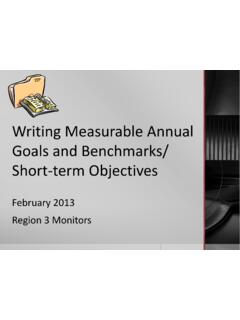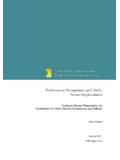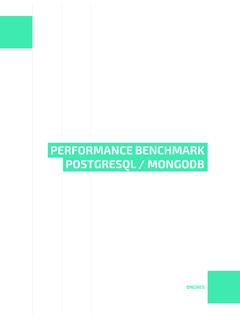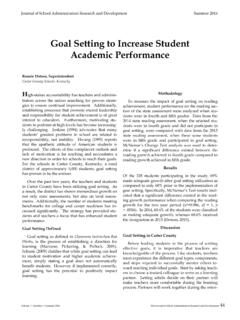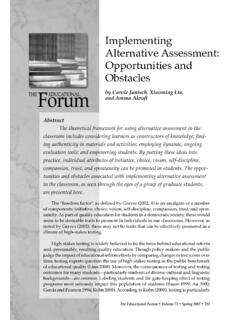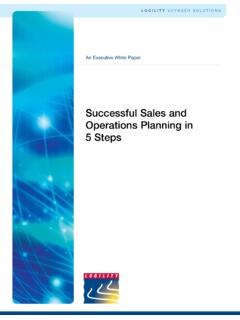Transcription of Improving Public Sector Efficiency: Challenges and ...
1 ISSN 1608-7143 OECD Journal on BudgetingVolume 7 No. 1 OECD 20071 Improving Public Sector Efficiency: Challenges and OpportunitiesbyTeresa Curristine, Zsuzsanna Lonti and Isabelle Joumard*This article examines key institutional drivers that may contributeto Improving Public Sector efficiency and focuses on one of them inmore detail: performance information and its role and use in thebudget process ( performance budgeting ).* Teresa Curristine is a Policy Analyst in the Public Governance and TerritorialDevelopment Directorate of the OECD. Zsuzsanna Lonti is a visiting academic in thesame directorate. Isabelle Joumard is a Senior Economist in the EconomicsDepartment of the OECD. This article was produced for the German Presidency ofthe European Public Sector EFFICIENCY: Challenges AND OPPORTUNITIESOECD JOURNAL ON BUDGETING VOLUME 7 No.
2 1 ISSN 1608-7143 OECD 20072 Executive summaryGovernments of OECD countries are under pressure to improve publicsector performance and at the same time contain expenditure growth. Whilefactors such as ageing populations and increasing health care and pension costsadd to budgetary pressures, citizens are demanding that governments be mademore accountable for what they achieve with taxpayers money. This articlebriefly reviews key institutional drivers that may contribute to improve publicsector efficiency, and focuses on one of them in more detail: performanceinformation and its role and use in the budget is no blueprint for enhancing Public Sector efficiency. OECD countries have thus adopted diverse approaches to reforming key institutionalarrangements, which include: increasing devolution and decentralisation;strengthening competitive pressures; transforming workforce structure, size,and HRM arrangements; changing budget practices and procedures; andintroducing results-oriented approaches to budgeting and the majority of OECD countries have engaged in some institutionalreforms, the empirical evidence of their impact on efficiency is so far limiteddue to: the lack of resources to conduct evaluations; the lack of pre-reformmeasures of performance; the complexities in measuring efficiency1 in thepublic Sector .
3 And the problem of isolating the effects of specific institutionalreforms on efficiency from other external evidence nevertheless suggests that the following threeinstitutional factors may improve Public Sector performance: Decentralisation of political power and spending responsibility to sub-national governments. Appropriate human resource management practices. In the education and health sectors, there is evidence that increasing thescale of operations may improve the use of performance information in budget processes is animportant initiative that is widespread across OECD countries. It is part of anongoing process that seeks to move the focus of decision making in budgetingaway from inputs (how much money can I get?) towards measurable results(what can I achieve with this money?). Improving Public Sector EFFICIENCY: Challenges AND OPPORTUNITIESOECD JOURNAL ON BUDGETING VOLUME 7 No.
4 1 ISSN 1608-7143 OECD 20073 OECD countries have reported a number of benefits from the use ofperformance information (PI): It generates a sharper focus on results within the government. It provides more and better information on government goals and priorities,and on how different programmes contribute to achieve these goals . It encourages a greater emphasis on planning and acts as a signalling devicethat provides key actors with details on what is working and what is not. It improves transparency by providing more and better information toparliaments and to the Public , and has the potential to improve publicmanagement and countries, however, continue to face a number of Challenges with theuse of PI in the budget process, including how to improve the measurement ofactivities, the quality of information, and getting politicians to use it in these Challenges , countries are evolving their approaches, notdiscarding them.
5 The OECD has developed general guidelines for countries asthey adopt and evolve initiatives to improve the use of PI in budgeting important factors to consider in this respect are: There is no one model of performance budgeting; countries need to adapttheir approach to the relevant political and institutional context. A common whole-of-government planning and reporting framework isimportant. PI should be integrated into the budget process. Designing government-wide systems that automatically link performanceresults to resource allocation should be avoided, because they may distortincentives and because it is difficult to design systems that take account ofthe underlying causes of poor performance. Independent assessments of performance information should be carried out. The support of political and administrative leaders is vital for implementation.
6 The staff and resource capacity of the ministry of finance (MOF) andspending ministries is critical. Reform approaches need to be adapted to evolving circumstances. It is important to develop incentives to motivate civil servants andpoliticians to change their citizens continue to demand better value for money for their taxpayments, there will be a continuing need for PI. Although the speed andmethods of reforms will vary across countries, it is vital that countriesrecognise that a long-term approach is necessary, that implementing PI inbudgeting is clearly a learning-by-doing process, and that the journey can beas important as the Public Sector EFFICIENCY: Challenges AND OPPORTUNITIESOECD JOURNAL ON BUDGETING VOLUME 7 No. 1 ISSN 1608-7143 OECD 20074 This article was produced for the German Presidency of the EuropeanUnion.
7 The article is divided into two The first briefly examinesefficiency measurement issues across countries and provides a review of theliterature on potential institutional drivers. The second examines one of thesedrivers in more detail the use of performance information in the budgetprocess across OECD countries as this is considered a particularly importantfactor for Public Sector Institutional drivers of Introduction: setting the sceneProviding more Public services with less Public spending is an ongoingchallenge for all OECD member countries which is becoming increasinglyimportant in the context of ageing. Cross-country comparisons could be useful toidentify best practices in delivering Public services in a cost-effective manner. Inpractice, the paucity of data often makes it difficult to benchmark countries, butrecent attempts at doing so in the education Sector where the lack of outputdata is a less severe constraint reveal that efficiency shortfalls can be large.
8 Also,the variety of OECD country approaches to managing Public spendingprogrammes provides useful insights about possible strategies for improvingvalue for money. In that respect, stepping up the use of performance informationin budget processes performance budgeting is an important dimension ofthe reforms undertaken by OECD countries since the early developments in Public spending leave no room for of Public spending to GDP have fallen below their historical high in theearly 1990s in the OECD area, Japan being a notable exception. However, thefactors behind this positive development Improving cyclical conditions,privatisation and enterprise restructuring, and lower debt servicing costs, forexample are unlikely to exert the same influence going Meanwhile,demands on social transfer systems have remained intense over the past twodecades; spending on pensions, poverty alleviation programmes and core meritgoods (education and health) continued on a clear upward trend during thatperiod.
9 Population ageing will put further significant pressures on publicspending in virtually all OECD countries over the next few cross-country comparisons of Public spending efficiency requirescorresponding measures of the value of Public service outputs and inputs. Onthe input side, even the Public spending data available from the nationalaccounts which are the best internationally comparable source are fraughtwith problems. Cross-country comparisons based on Public spending-to-GDPratios suggest significant differences across OECD countries. However, manyof these variations reflect the different approaches to delivering Public goodsand providing social support rather than true differences in resources spentIMPROVING Public Sector EFFICIENCY: Challenges AND OPPORTUNITIESOECD JOURNAL ON BUDGETING VOLUME 7 No.
10 1 ISSN 1608-7143 OECD 20075on Public services. For example, if support is given via tax breaks rather thandirect expenditure, expenditure-to-GDP ratios will naturally be Public spending outputs is even more complex. The coverageand scope of Public services differ across countries, partly reflecting societalpriorities. These disparities require that Public spending effectiveness beassessed by spending area, at least for the key components, including healthcare, education and social assistance. Even for each of these spending areas, Public involvement often has various objectives (or output targets). And theoutcomes of Public services also depend on a number of factors that areoutside the control of policy makers, at least in the short run. (Life expectancy,for example, depends to a large extent on lifestyle and diet.)










